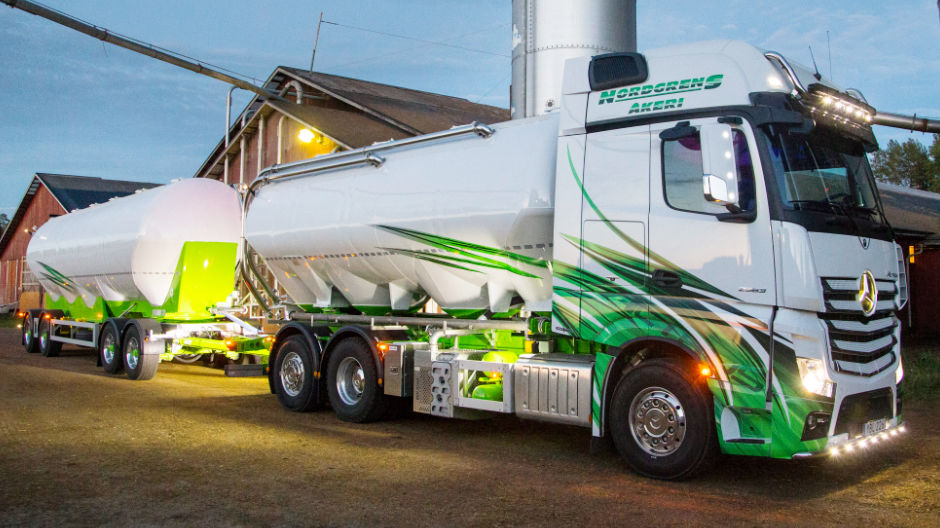
Lantmännen co-operative's flagship: Nordgren's Mercedes-Benz Actros
Actros
When Allan Nordgrens Åkeri AB's silo combination drives into a farmyard in Umeå, it certainly doesn't go unnoticed. The vehicle is a Mercedes-Benz Actros 2563 – elegantly painted and adorned with interesting decals which draw their inspiration from plants. All of the details have been precisely thought-out.

With their new Mercedes-Benz Actros, Nordgrens Åkeri delivers feeds in Umeå.
The Nordgrens Åkeri haulage firm's headquarters are in Vännäs in northern Sweden's Västerbotten region. The company's truck of choice is the Actros when it comes to the regular transportation of animal feed on behalf of Lantmännen, the Europe-wide agricultural co-operative. The bulk materials transporter brings cattle, pig and chicken feed to farmyards over the vast majority of northern Sweden: from Piteå in the north, heading further south as far as Härnösand. Besides this type of task, the Actros is also used for transporting fuel pellets to businesses and private customers.
“I bought the truck last September. Since then, it's covered 130,000 km. It's my third Mercedes-Benz – I bought my first one in 2006. I'm very happy with it. Vehicles are always a matter of taste. But the fact that I picked a Mercedes also has to do with the fact that there's a really good salesman at Bil-Dahl in Umeå!”
Allan Nordgrens Åkeri AB was founded in 1984 and serves as Lantmännen's calling card in the region. Magnus Nordgren and his two drivers enjoy the close contact with customers as well as the fact that they get to see something different every day. Work is never boring: you drive a bit, then you're at that location for a while. There you can enjoy a bit of chin-wag with the customers while you help them with whatever needs doing.
In a single shift, the transport company rarely covers more than 300 km. The vehicle travels between Bjurholm, Robertsfors, Skellefteå, Umeå and Örnsköldsvik. Allan Nordgrens Åkeri uses diesel and, if available, HVO (hydrogenated vegetable oil).
German manufacturer Feldbinder built the vehicle and the trailer, while the decals on the vehicle are from Troeng Design in Järfälla. The interior appointments of the cab were adopted from K Järpelands Hyttinredning in Bjurholm. The cab interior is black, white and light green, with button-studded leather. On the underside of the folding upper bed, there is a light-green Mercedes star – something nice to look at when you're lying down underneath it.
“Every new Mercedes generation that I've bought has delivered reductions in fuel consumption. I really don't have anything to complain about.”
– Magnus Nordgren
Allan Nordgrens Åkeri AB delivers both to towns and the countryside. If the haulage firm's drivers have to deliver four tonnes of fuel pellets to an apartment building, they remove the truck's steel pipe and connect it to the aluminium filler neck on the connecting pipe of the building's wall.
Click here to leave RoadStars and to find out more information within Google Maps: Map on Google Maps
Then, the driver adds pressure to the tank, using a compressor capable of delivering 19 cubic metres of air per minute. The driver puts on his or her ear protectors and blows the pellets out of the silo – doing so carefully to ensure that the porous load doesn't fall to pieces.
“Pressure can be added to each chamber individually. The vehicle's aluminium tank can house as much as 35 cubic metres of the product, divided between four chambers. The tanker trailer contains 55 cubic metres, split across five chambers. At 64 tonnes total weight, the vehicle/trailer combination can handle a load of 12 tonnes on the truck itself and 30 tonnes in the trailer,” explains Magnus Nordgren.
At the rear of the vehicle, all of the outlet pipes are bundled together and the truck is equipped with a ten-metre-long steel pipe while the trailer's pipe measures five metres. What's more, the vehicle has a five-metre-long aluminium extension pipe which can also be used.
Filling the vehicle is carried out at Lantmännen's feeds factory in Holmsund. The driver opens the flap above the tank and lets down the bellows which is inserted in the openings of the chambers. The loading system functions automatically and determines the quantity of feed with which the vehicle should be filled. As there are various chambers, different types of feed can also be transported at one time.
“Up to now, there have been no problems with the vehicle. The service intervals are every 150,000 km, so up to now, I haven't actually seen the workshop with this truck.”
– Magnus Nordgren
Photos: Joachim Cruus




Comment
Please log in to post a comment.
11 comments
Aber 42 Tonnen laden , das sind Belege .
Aber 42 Tonnen laden , das sind Belege .